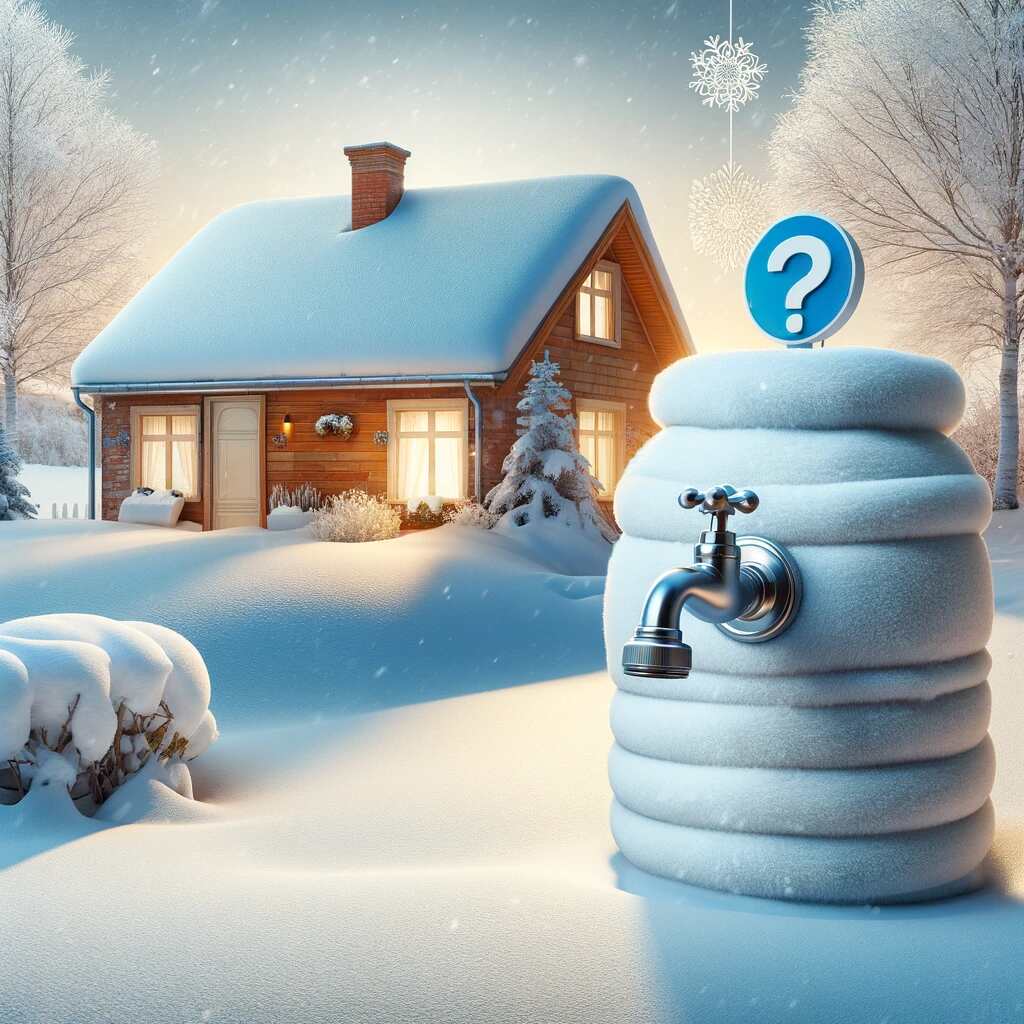When winter arrives and temperatures drop, homeowners often wonder whether it’s safe to use their outdoor faucet or spigot during the cold season. Using an outdoor faucet in winter can be a convenience for various tasks, but it can also pose some risks if not done correctly. So, can you use your outdoor faucet in winter?
Yes, you can use your outdoor faucet in winter, but it requires precautions. Outdoor faucets are susceptible to freezing, which can lead to pipe bursts and damage. To use them safely, insulate the faucet, use heat tape if necessary, and drain it when not in use. Installing a frost-free faucet is another option.
Stay for the comprehensive guide. Let’s explore the considerations, precautions, and steps to ensure you can safely use your outdoor faucet in winter without causing damage or freezing pipes.
Understanding the Concerns
Before delving into whether you can use your outdoor faucet in winter, it’s essential to understand the potential problems that may arise when exposing your plumbing to freezing temperatures.
1. Freezing Pipes
The primary concern during winter is the risk of freezing pipes. When water inside your pipes freezes, it expands, which can lead to pipe bursts and costly water damage. Outdoor faucets are particularly vulnerable because they are exposed to the cold air, making them susceptible to freezing.
2. Water Damage
If a pipe bursts due to freezing, it can lead to significant water damage to your property. Water damage can be expensive to repair and may also cause structural damage or mold issues if not addressed promptly.
3. Faucet Damage
The outdoor faucet itself can also be damaged by freezing temperatures. The components, including the valve and handle, may crack or break if they freeze.
Steps to Safely Use Your Outdoor Faucet in Winter
While it’s generally not advisable to use outdoor faucets during freezing temperatures, there are steps you can take to safely use them when necessary.
1. Insulate the Faucet
One of the most effective ways to protect your outdoor faucet from freezing is to insulate it. You can purchase faucet covers or wraps designed specifically for this purpose. These covers are made from various materials like foam or fabric and help to keep the cold air away from the faucet.
To insulate your faucet, follow these steps:
- Remove any hoses or attachments from the faucet.
- Place the insulating cover over the faucet, ensuring it covers the entire spigot and extends down the pipe.
- Secure the cover in place using straps or ties.
This insulation creates a barrier between the cold air and the faucet, reducing the risk of freezing.
2. Use Heat Tape
Heat tape, also known as heating cable, is another option to prevent freezing. It’s a flexible electrical heating element that you wrap around your outdoor faucet and pipe. Heat tape is designed to generate heat and keep the pipes warm, preventing freezing.
Here’s how to use heat tape:
- Wrap the heat tape around the faucet and pipe.
- Secure it in place with tape or clips.
- Plug in the heat tape to activate the heating element.
Make sure to follow the manufacturer’s instructions carefully when using heat tape. It’s essential to install it correctly to prevent any fire hazards or electrical issues.
3. Drain the Faucet
Another method to avoid freezing is to drain the outdoor faucet completely. When the faucet is not in use, water can remain trapped inside, leading to freezing. To drain the faucet, follow these steps:
- Turn off the water supply to the outdoor faucet. This is typically done by closing the valve inside your home.
- Open the outdoor faucet to allow any remaining water to drain out.
- Leave the faucet in the open position to prevent any trapped water from freezing and causing damage.
4. Install a Frost-Free Faucet
If you frequently need to use your outdoor faucet during the winter months, consider installing a frost-free faucet. Frost-free faucets are designed with the valve located inside your home, where it’s protected from freezing temperatures. When you turn off the faucet, it drains the water from the exposed portion, preventing freezing.
Installing a frost-free faucet may require professional plumbing work, so consult with a plumber if you’re considering this option.
5. Keep the Faucet Closed
When you’re not actively using your outdoor faucet during winter, it’s a good practice to keep it closed tightly. This prevents cold air from entering the pipe and reduces the risk of freezing. Remember to disconnect any hoses or attachments as well.
6. Monitor the Weather
Stay informed about the weather forecast, especially during the coldest months of winter. If a severe cold snap is expected, take extra precautions, such as using insulation or heat tape, even if you don’t plan to use the faucet. Being proactive can prevent costly damage.
Tasks You Can Perform with an Outdoor Faucet in Winter
While using your outdoor faucet during winter requires caution, there are several tasks where it can be beneficial:
1. Watering Plants
If you have winter-hardy plants that need occasional watering, using your outdoor faucet can be a convenient way to do so. Just remember to drain the faucet and protect it from freezing when not in use.
2. Pet Care
Providing water for your outdoor pets during the winter months is essential. You can use your outdoor faucet to fill their water bowls. Ensure the faucet is insulated and protected to prevent freezing.
3. Cleaning
Some outdoor cleaning tasks, like washing off outdoor equipment or removing snow and ice from surfaces, may require the use of an outdoor faucet. Be sure to take the necessary precautions to prevent freezing.
When Not to Use Your Outdoor Faucet in Winter
While there are tasks you can safely perform using your outdoor faucet in winter, there are situations where it’s best to avoid using it altogether:
1. Extremely Cold Temperatures
During extremely cold temperatures, even with insulation and other precautions, the risk of freezing remains high. It’s best to avoid using the outdoor faucet during severe cold snaps.
2. Frozen Ground
If the ground around your outdoor faucet is frozen, it may be challenging to use the faucet without causing damage to the surrounding area. Wait until the ground thaws before using the faucet.
3. Unused Faucets
If you have outdoor faucets that you rarely use during winter, it’s advisable to shut off the water supply to those faucets and drain them. This minimizes the risk of freezing and potential damage.
Winterizing Your Outdoor Faucet
Winterizing your outdoor faucet is an essential part of ensuring it remains functional and undamaged during the winter months. Here are the steps to properly winterize your outdoor faucet:
1. Remove Hoses and Attachments
Start by disconnecting any hoses, attachments, or accessories from the outdoor faucet. Leaving these items attached can trap water, increasing the risk of freezing.
2. Turn Off the Water Supply
Locate the shut-off valve for the outdoor faucet inside your home. Turn it off to stop the flow of water to the faucet. This step is crucial in preventing freezing.
3. Drain the Faucet
Open the outdoor faucet to allow any remaining water to drain out. Keep the faucet in the open position throughout the winter season to prevent water from accumulating and freezing.
4. Insulate the Faucet
Apply insulation to the outdoor faucet. You can use a faucet cover or wrap it with insulating materials like foam or fabric. Ensure that the entire spigot and a portion of the connected pipe are covered.
5. Install Heat Tape (Optional)
If you live in an extremely cold climate and want an additional layer of protection, you can install heat tape as mentioned earlier. This will provide a source of heat to prevent freezing.
6. Monitor Regularly
Throughout the winter, periodically check your outdoor faucet to ensure it remains in good condition. Look for signs of freezing or damage, and address any issues promptly.
Signs of Frozen Pipes and Faucets
Despite taking precautions, it’s still possible for outdoor faucets and pipes to freeze during severe cold spells. Here are some signs to watch for:
1. No Water Flow
If you try to use the outdoor faucet during winter, and no water comes out, it may be a sign of frozen pipes. Do not force the faucet open, as this can cause damage.
2. Strange Noises
Frozen pipes may produce strange noises, such as popping or cracking sounds. These noises can indicate that ice is forming inside the pipes.
3. Visible Frost
If you notice frost or ice on the exterior of the faucet or along the connected pipe, it’s a clear sign of freezing. Take immediate action to prevent further damage.
4. Bulging or Burst Pipes
In severe cases, frozen pipes can lead to bulging or burst pipes. If you see any signs of damage, shut off the water supply and consult a plumber.
Conclusion
In conclusion, the usability of your outdoor faucet in winter depends on its design and the precautions you take. If it’s a frost-resistant type with proper insulation and drainage, it can be used safely. However, without these measures, the risk of freezing and faucet damage is significant.
Always prioritize winterization and care to enjoy the convenience of your outdoor faucet while avoiding costly plumbing issues.








